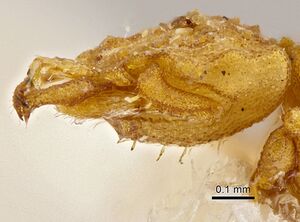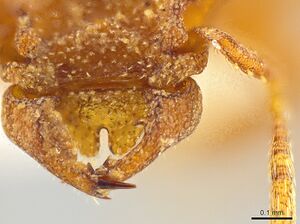Rhopalothrix apertor
| Rhopalothrix apertor | |
|---|---|

| |
| Scientific classification | |
| Kingdom: | Animalia |
| Phylum: | Arthropoda |
| Class: | Insecta |
| Order: | Hymenoptera |
| Family: | Formicidae |
| Subfamily: | Myrmicinae |
| Tribe: | Attini |
| Genus: | Rhopalothrix |
| Species: | R. apertor |
| Binomial name | |
| Rhopalothrix apertor Longino & Boudinot, 2013 | |
This species occurs in lowland rainforest, from 150–500m elevation. All specimens are from Winkler samples of sifted leaf litter. It is rare: it occurred in three of 208 Project ALAS Berlese samples, and three of over 1500 TEAM project miniWinkler samples. (Longino and Boudinot 2013)
Identification
Masticatory margin of mandible dominated by a single, blunt, peg-like tooth; tooth at base of subapical tooth, instead of being the small reclinate denticle typical of other species, is a distinct recurved tooth, directed posteriorly; first gastral tergite largely devoid of setae, with one pair of squamiform setae at posterolateral margins; first gastral sternite with pronounced median keel, this keel weak to absent in other species. (Longino and Boudinot 2013)
Keys including this Species
Distribution
Latitudinal Distribution Pattern
Latitudinal Range: 10.4043653° to 9.5802747°.
| North Temperate |
North Subtropical |
Tropical | South Subtropical |
South Temperate |
- Source: AntMaps
Distribution based on Regional Taxon Lists
Neotropical Region: Costa Rica (type locality).
Distribution based on AntMaps
Distribution based on AntWeb specimens
Check data from AntWeb
Countries Occupied
| Number of countries occupied by this species based on AntWiki Regional Taxon Lists. In general, fewer countries occupied indicates a narrower range, while more countries indicates a more widespread species. |

|
Estimated Abundance
| Relative abundance based on number of AntMaps records per species (this species within the purple bar). Fewer records (to the left) indicates a less abundant/encountered species while more records (to the right) indicates more abundant/encountered species. |

|
Biology
|
Castes
Worker
Images from AntWeb
  
| |
| Worker. Specimen code inbiocri001239546. Photographer Brendon Boudinot, uploaded by University of Utah. | Owned by INBio. |
 
| |
| Specimen code casent0629587. . | |
 
| |
| Specimen code casent0629588. . | |
  
| |
| Holotype Rhopalothrix apertor. Worker. Specimen code casent0629589. Photographer Brendon Boudinot, uploaded by University of Utah. | Owned by CAS. |

| |
| . | |
Queen and Male
Images from Borysenko (2022)
Nomenclature
The following information is derived from Barry Bolton's Online Catalogue of the Ants of the World.
- apertor. Rhopalothrix apertor Longino & Boudinot, 2013: 309, figs. 1F, 2B, 3A, 6, 16 (w.) COSTA RICA.
Unless otherwise noted the text for the remainder of this section is reported from the publication that includes the original description.
Workers of this species fall into two distinct size classes. Five specimens have HW 0.54–0.58. Four of these are from La Selva Biological Station (50–150 m elevation), all from different samples, and one is from a 500 m elevation site on the Barva Transect above La Selva. A series of three specimens from one miniWinkler sample (and thus probably from the same colony) have HW 0.74, longer and relatively thinner mesotibiae, and a more robust flattened mandibular base. These are from immediately adjacent to La Selva, at 160 m elevation. There is the potential that they are two cryptic species. The holotype and paratype were chosen from the one series of larger workers.
Description
Worker
HW 0.54–0.74 (n=6); masticatory margin of mandible with single large blunt, in some almost capitate, tooth at about mid-length, a tiny denticle proximad, base of subapical tooth with prominent recurved acute tooth, directed posteriorly, subapical tooth shorter than width of mandible at base, about twice as long as apical tooth, only one intercalary tooth present, outer margin of mandible broadly flattened at base; labrum about as long as broad, with two long, bluntly rounded anterior lobes, sinus between them deep, length of anterolateral lobe longer than or about equal to distance from base of sinus to transverse carina at base of labrum; arcuate promesonotal groove and metanotal groove strongly impressed; propodeal tooth small, at about midlength of posterior face of propodeum, infradental lamella very narrow; first gastral tergite largely devoid of setae, with one pair of squamiform setae at posterolateral margins; first gastral sternite with pronounced median keel.
Type Material
Holotype, worker: Costa Rica, Heredia: 7 km SW Pto Viejo, 10.40389 -84.03944 ±500 m, 160 m, 4 Mar 2005, mature wet forest, ex sifted leaf litter (TEAM#AMI-2-W-033-01) California Academy of Sciences, unique specimen identifier CASENT0629589. Paratypes (workers): same data as holotype National Museum of Natural History, CASENT0629588; Museum of Comparative Zoology, INB0003667720.
Etymology
The mandible looks like a bottle opener.
References
- Borysenko, L.H. 2022. The male of the ant genus Rhopalothrix (Hymenoptera: Formicidae: Myrmicinae). Neotropical Entomology 51, 413–422 (doi:10.1007/s13744-022-00947-w).
- Longino J. T. and Boudinot B. E. 2013. New species of Central American Rhopalothrix Mayr, 1870 (Hymenoptera, Formicidae). Zootaxa. 3616:301-324. doi:10.11646/zootaxa.3616.4.1
References based on Global Ant Biodiversity Informatics
- Longino J. T. L., and M. G. Branstetter. 2018. The truncated bell: an enigmatic but pervasive elevational diversity pattern in Middle American ants. Ecography 41: 1-12.
- Longino J. T., and B. E. Boudinot. 2013. New species of Central American Rhopalothrix Mayr, 1870 (Hymenoptera, Formicidae). Zootaxa 3616: 301-324.
- Longino J. et al. ADMAC project. Accessed on March 24th 2017 at https://sites.google.com/site/admacsite/






